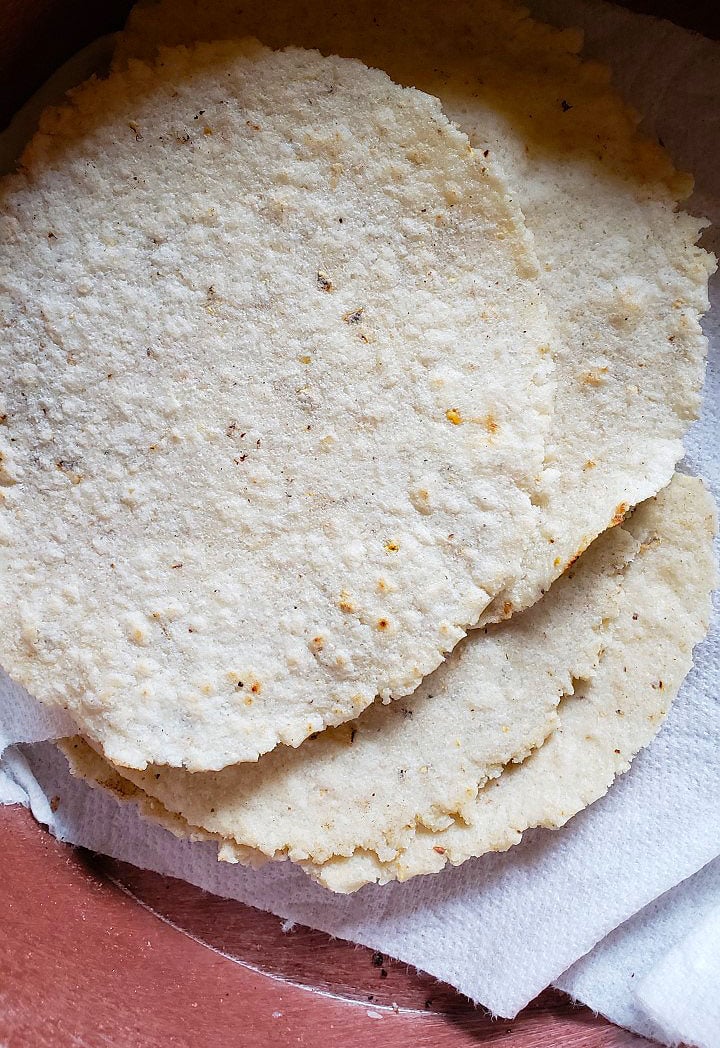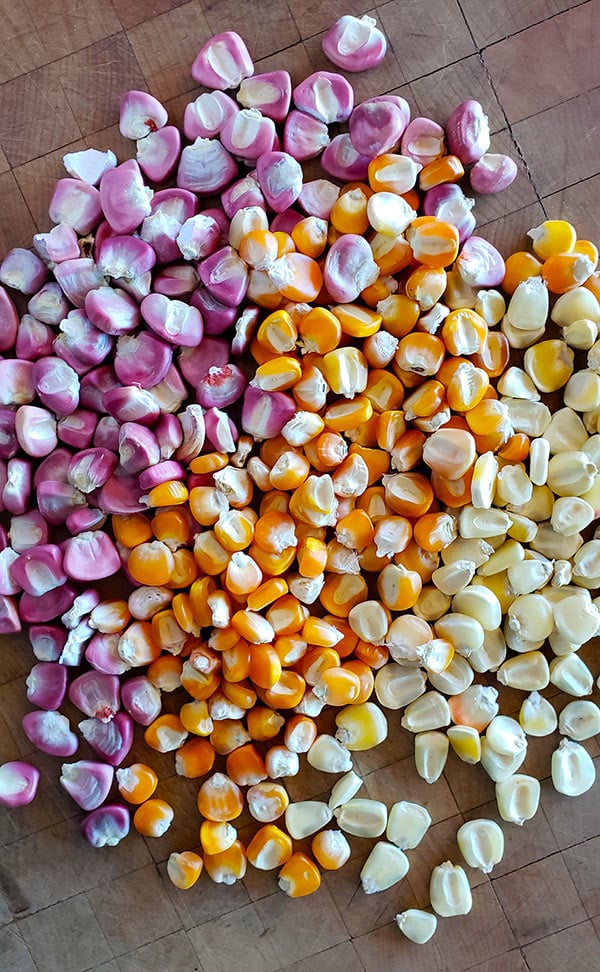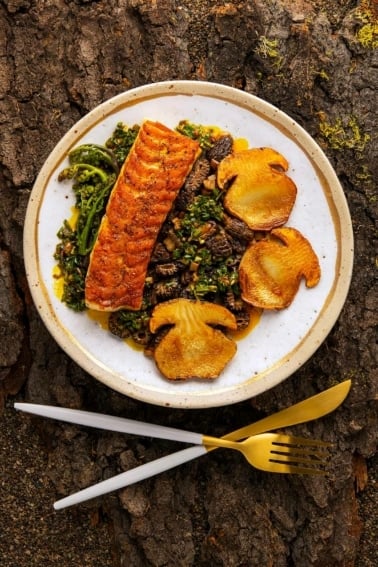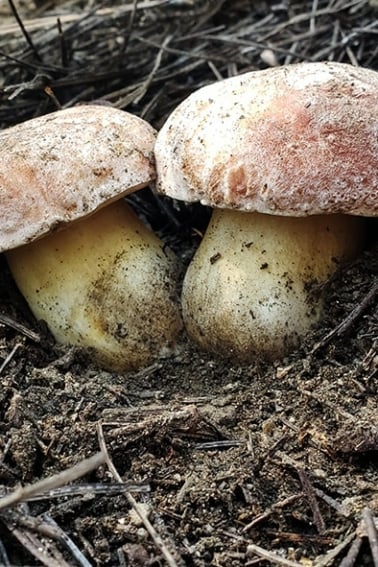As an Amazon Associate I earn from qualifying purchases.

These are my tortillas. They are made from Mexican heirloom corn I nixtamalized myself, ground twice, then formed and griddled on an iron comal. I am not proud of them. But I am getting better.
I know, they look pretty nice. But these tortillas are too thick, and were slightly brittle. They did not break in half, but they were not nearly so flexible as they should be. I suspected my masa was too dry, not quite cooked enough, and that my comal was too cool, facts confirmed by my friend Patricio Wise, a chef from Nuevo Leon, Mexico.
At least they tasted good.
I’ve been making a lot of tortillas lately. There is a reason for this that goes beyond whipping up a batch of tacos.
A great many good things in this life hinge on the perfect execution of something that is simple, but not easy. Writing a good sentence. Shooting a rifle. Casting a line. Driving to work. Being on time.
In food, show me a cuisine and I will show you that hinge. If you walk into a French restaurant and want a job, many chefs will ask you to make an omelet. Go to the Italian place, and chef will likely ask you to make pasta. Cajun joint? How good do you do roux, breaux?
In Mexico, it is the tortilla. These disks of either corn or flour are literally the foundation of that cuisine. But unlike sex, bad tortillas are just bad. And I have eaten a great many bad tortillas.
Flabby, factory-made tortillas that stink of industrial cleaners. Sour tortillas sweating in plastic bags for who-knows-how-long. Flour tortillas that were really Italian piadine flatbreads and yes there is a difference. Well-meaning home cooks making flour “tortillas” puffier than pita. Sad tortillas kluged together from cheap masa harina, which is to real masa what Golden Corral is to the French Laundry.
And don’t get me started on those pre-bent, hard-shelled Ortega monstrosities. Who thought that having your edible wrapper shatter at the first bite was fun?
Despite all this, I’ve had quite a few good tortillas, too. But I’ve had precious few great tortillas. One that lingers is a flour tortilla made by Tortillas Mi Pueblito in Mammoth, Arizona. Another is a corn tortilla handmade by Patricio.

To me, a great tortilla is not only mechanically perfect — thin and flexible — but it also has levels of flavor so rich that they are delicious unadorned. The experience starts before you even get the tortilla to your lips. They are round but not perfect. They are freckled with char. And the aroma of good wheat or good corn grabs you and holds on.
That aroma leads to flavor. Good corn, especially, satisfies every bit as much as good wheat: Better even, when you consider that a wheat tortilla requires lard, and lots of it. Corn tortillas are just corn, water and maybe salt.
Most people never bother with homemade tortillas. Most people buy them with no more thought than which brand they prefer, if that. Don’t get me wrong, I buy tortillas, too, for the same reason everyone else does: expediency.
But at least for me, to understand Mexican cooking, really understand it, I must be able to make a good tortilla.
It’s part of the whole stand-before-you-walk, walk-before-you-run philosophy I have always tried to follow. Jackson Pollock did not start his art career splashing paint on a giant canvas. Almost every day I wake up hot with ideas about how I can experiment with this ingredient or that cuisine, but always I hear my inner voice scolding me for cherry picking.
Sure, I can make a pretty good pipian or tamal, and even a decent mole.
But if I were to walk up to the great Mexico City chef Enrique Olvera and ask to work at his restaurant Pujol, chances are he’d ask me to make a tortilla. And even if he didn’t, I’d be mortified if I could not do so among such great Mexican chefs.
It took me years to become an accomplished pasta cook. I am good enough at it now that I would not fear to make cavatelli or gnocchi or tajarin for an Italian chef. I don’t know how long it will take me to become a competent tortillero. But I am working on it.
As usual, it’s the little things, things that are not in any recipe I have read in either English or Spanish. Even armed with a good recipe, I have not yet made a flour tortilla half as good as I’d like. Some taste like bread. Some were too thick. Others ballooned rather than bubbled, making a few large char spots, not lots of little ones.
Too much lard? Not enough? Comal too hot? Was the dough rested too much or too little? Hell, even rolling out tortillas is a skill.
Easier with corn tortillas, but when I make them super thin they break as I try to peel them off the pieces of plastic I use to prevent the masa from sticking to my tortilla press. Maybe use thinner plastic, like a grocery bag instead of a heavy freezer bag? So many little details…
If you think about it, the singular act of making a memorable tortilla is a skill valued for millennia in Mexico. A skill, in the past, used to gauge a woman’s value as a wife, and even today a cook’s value in the kitchen regardless of gender.
Given this, it would be downright insulting for me, or anyone jumping into this, to think we could nail it in the first, tenth or even hundreth time. I am so good at cooking duck breasts and filleting fish because I have done these tasks literally thousands of times. So it will be with making tortillas from scratch.
More failures lie ahead. And that’s OK. It’s worth it.





Oh, and I’ve been using parchment paper vs plastic – another option! 🙂
Hank,
I’ve recently gone down this road and I’m thrilled you’re aiming for tortilla skills too (so I can crib your tips of course)!
I’m only interested in corn (gluten allergy), but I’m proud that I’ve eaten my first bag of retail masa, the slow way! However, I have questions about better sources of masa or corn.
If you have even preliminary tips on sourcing I’d be thrilled!
Thank you!
Crystal
Great article, Hank. I recently attempted to make corn tortillas with fresh heirloom corn meal that my sister brought to me for a taco party. Corn tortillas with masa harina is so easy I assumed the fresh corn meal would make them that much better. Wrong! Dead wrong! Disaster ensued and we ended up breaking out the masa harina anyway. I am however motivated to learn how to properly tortilla. Could you please recommend a couple of good links or cook books on where one should begin to learn the art of the tortilla?
Thanks , Hank, and keep up the great work!
The corn tortillas in Oaxaca are like nothing I’ve had anywhere else. They are almost grey in color, but so flavorful. It must be the local corn… Same goes for the flour tortillas from Anita Street Market in Tucson. They make some called “Gorditas” that are not fat, but have requesón (similar to ricotta) in them that makes them silky smooth (I told Patricio Wise about them and he said he uses whey from his queso fresco). I’ve tried to replicate them using requesón (and some whey from making some Mozzarella)–I’m getting closer, but whereas they use vegetable shortening, I use lard from the local Mexican market. I first made them with some Mexican all purpose flour but they were so stretchy you’d roll them out and they’d spring back to almost the original size. I last used some Sonoran flour from Hayden Mills and they were closer to Anita Street’s, but I’m sure they don’t use Hayden Mills–and they aren’t telling what they use. I’ll be back there in May and try to get more information from them… It’s fun!
Thanks Hank, makes my journey seem worthwhile. I grew some blue corn last year, which were all consumed as tortillas and growing some more from the seed now.
Your post brings back wonderful childhood memories of my great-grandfather’s annual visits. He was married to Minga, who had made homemade flour tortillas almost every day of her life. There was nothing like the delicious simplicity of tortillas hot off the griddle, plain, or with butter or cheese.
I watched her make them hundreds of times, but she never measured anything, and my aunt’s attempts to replicate them were a dismal failure. I have always wanted to try myself, but have procrastinated because I know that I, too will make many mistakes. Your post has inspired me to get busy.
One thing I’ll need, which was Minga’s choice tool, was a 1” galvanized pipe, about 8” long, for rolling out her dough.
Jill: I use a sawed off wooden dowel a little thinner in diameter than the length of my pinkie finger.
Years ago I watched my Belizean friend make flour tortillas. So easy. She taught me how, but I only got as far as you and haven’t tried in years. Edible, but not that perfect combination of flexibility and flavor that you talk about. She would form them on her counter top, working the disk of dough from the center in concentric rings until she had a 10 inch tortilla that was nearly perfectly round and uniform thickness. Amazing. Makes me want to go back for another lesson.
Salud, amour y dinero, I toast you with an imaginary shot of the best tequila! Straight down at 9 AM on Valentine’s Day… Remembering life along the Baja border in the 60s and 70s.
Add “una pequitita de baking powder” that’ll fix them sometimes.
Mike: Only for flour tortillas, no? I’ve heard that trick for flour, not for corn.
When you get it down, you know it. It’s like prepping masa for tamales. A good masa, neither too dry, nor too greasy, can be enjoyed without any filling. Thanks for the great read.
I will never forget watching my mom make my dad his tortillas de harina, every morning for his lunch. A warm tortilla, with butter and salt, brings back so many memories of my childhood.
Yep, I can relate to this one. Mi esposa es de Ensenada. Mi Madre in law makes tortillas that will blow your mind. We try and duplicate what Mom can do, but fail miserably in the process. I’m getting closer, but still a long way to go for something that seems so simple.
Ciao, Steve
Hank, I am an xpat living in Mexico with a Mexican wife. Do you use Cal, which is used in making cement here, a white powder I think might be lime to soak over night the corn in. Then you grind it either with and hand cranked grinder or an electric one (we have both). Then the resulting masa can be formed with the tortilla press with plastic bag cut into two pieces as you mentioned. We also have a crank circular with cutters on the cylinder dealie that you feed the masa into, kind of like a pasta maker roller dealie (which we also have and use). It is kind of finicky though on how moist the masa is. But if you have to make tortillas for a bunch of people worth having once you get it set up and rolling. We use blue corn, white corn, all kinds, each with a slightly different palate.
For some reason when I read the first few lines I was imagining the scene from Apocalypse now: “This is my tortilla. There are many like it, but this one is mine”. 🙂
Fresh tortillas are so hard to get right, and so widely available, it can be hard to justify making them myself, but, sometimes it really is the small things that can help you to begin to understand a cuisine. I’m still working on finding a way to nixtamalize corn that doesn’t involve ash water all over my stove. What do you use?
Alan: First off, that’s Full Metal Jacket. 😉
I use cal, which is available in any Latin market. Go to El Burrito Mercado and they will have it. You measure out 1% of cal by weight of the dry corn to nixtamalize.
Using ash is the Southern way to make hominy, and it requires a lot more ash, almost 1:1.
Just bought my first tortilla press and will be starting to practice soon!
I have also experimented with scratch made tortillas to mixed results. They always taste amazing but the thickness and texture plays a huge part. I find that the less than ideal ones still make a pretty fantastic enchilada inspired casserole. Masienda Bodega offers some quality product.
Joe: That’s where I get my corn, from Masienda. I like it a lot.
Making corn tortillas from scratch is a most worthwhile pursuit, one that I have been engaged in for many years. One thing you did not touch on in your story is how you are grinding your nixtamal, after it has been soaked and cooked in cal. Getting the nixtamal ground finely enough is essential–hard to press it thin enough if the grind is too coarse. Fine grinding wet corn doesn’t work well in a Corona mill or a food processor. For a long time, I was drying my nixtamal in a low oven, and then grinding it in the dry jar of my Vitamix–essentially making my own masa harina, which I would then rehydrate to make masa. Two Christmases ago I was gifted with an Ultra Dura wet grinder, made in India. I call it a motorized metate, because it has rotating volcanic cones that grind the wet nixtamal, which I first rough grind in my food processor, to get it started. It’s possible to find grind to the consistency of Play-doh, which is what you want for tortillas. If you are as serious about making tortillas as you seem to be, you may want to consider it. https://www.youtube.com/watch?v=MeWnHnFAxOc
Zora: Fascinating! That is a cool device. I have started grinding the nixtamal twice in a meat grinder, then buzzing in a food processor with a little of the soaking water until it balls up. It works, but you get masa too wet, so I have to add a little masa harina back in.
After leaving Mexifornistan for good (4 years ago), my appreciation for authentic Mexican cuisine has grown exponentially. Both my wife and I consider ourselves proficient at making genuine Mexican food from our very traditional Pico de Gallo to street tacos and Carnitas. But reading your missive about tortillas is quite humbling indeed. I must now pursue the ultimate tortilla!
Good read.
When I make papusas I use oiled deli wrap. I wonder if something like that might work for tortillas without the oil of course.
Thank you for sharing this! There isn’t enough emphasis (in any area of life) on the value of failure. Your eventual success (and, c’mon, we all know you’ll succeed) will be a true success because you’ve learned from your previous failed attempts. Now, try to teach my kids that, lol.
Awesome read Hank. Would love to see some posts along your process documenting your progress. A good corn tortilla is one of the great seemingly simple but overlooked culinary pleasures.